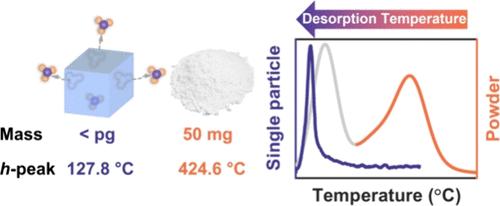Temperature-Programmed Desorption of Single Zeolite Nanoparticles
IF 15.6
1区 化学
Q1 CHEMISTRY, MULTIDISCIPLINARY
引用次数: 0
Abstract
Zeolites are essential solid acid catalysts in various chemical processes. Temperature-programmed desorption (TPD) is one of the most established techniques used to characterize the acidity of zeolites by measuring the desorption kinetics of probes from bulk samples. However, conventional TPD can hardly deliver the intrinsic acid properties of zeolites because the apparent desorption kinetics are inevitably mixed with mass transfer and thermal conduction due to the large sample amount (∼0.1 g). Herein, we developed an optical microscopy approach to measure the TPD spectra of single zeolite nanoparticles, termed oTPD, by in situ monitoring of the reduced scattering intensity of individuals as a result of the desorption of probe molecules during heating. A significantly reduced sample amount contributed to the oTPD spectrum, revealing an intrinsic desorption temperature of ∼300 °C lower than the apparent value and also a greatly narrowed peak width from ∼150 to ∼15 °C. Correlating oTPD and micro-Raman spectra of the very same individuals further uncovered a linear dependence between the acidity and the content of silicon islands. This study provided unprecedented capabilities for measuring the intrinsic acid properties and the desorption kinetics of single zeolite nanoparticles, with implications for better understanding the structure–acidity relationship and for designing better zeolite catalysts.

单个沸石纳米颗粒的温度编程解吸
沸石是各种化学过程中必不可少的固体酸催化剂。温度编程解吸(TPD)是通过测量块状样品中探针的解吸动力学来表征沸石酸性的最成熟技术之一。然而,由于样品量较大(∼0.1 克),表观解吸动力学不可避免地与传质和热传导混合在一起,因此传统的 TPD 难以反映沸石的内在酸性。在此,我们开发了一种光学显微镜方法来测量单个沸石纳米颗粒的 TPD 光谱(称为 oTPD),方法是原位监测加热过程中探针分子解吸导致的个体散射强度降低。明显减少的样品量有助于 oTPD 光谱,揭示了比表观值低 ∼300 °C的内在解吸温度,以及从 ∼150 °C到 ∼15 °C大大缩小的峰宽。对相同个体的 oTPD 和显微拉曼光谱进行相关分析,进一步发现了酸度与硅岛含量之间的线性关系。这项研究为测量单个沸石纳米颗粒的内在酸性和解吸动力学提供了前所未有的能力,对更好地理解结构与酸度的关系和设计更好的沸石催化剂具有重要意义。
本文章由计算机程序翻译,如有差异,请以英文原文为准。
求助全文
约1分钟内获得全文
求助全文
来源期刊
CiteScore
24.40
自引率
6.00%
发文量
2398
审稿时长
1.6 months
期刊介绍:
The flagship journal of the American Chemical Society, known as the Journal of the American Chemical Society (JACS), has been a prestigious publication since its establishment in 1879. It holds a preeminent position in the field of chemistry and related interdisciplinary sciences. JACS is committed to disseminating cutting-edge research papers, covering a wide range of topics, and encompasses approximately 19,000 pages of Articles, Communications, and Perspectives annually. With a weekly publication frequency, JACS plays a vital role in advancing the field of chemistry by providing essential research.

 求助内容:
求助内容: 应助结果提醒方式:
应助结果提醒方式:


